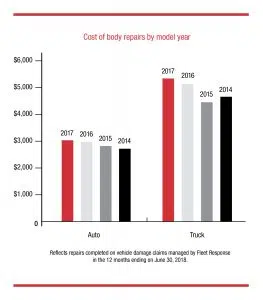16 Nov Ways to minimize ever-increasing repair costs

Every year, when new model vehicles are put into service in self-insured fleets, the cost to repair accident damage rises noticeably.
Here’s why:
Safety technology:
The advanced safety systems in cars today rely on an increasing array of sensors, relays, cameras and lasers that can dramatically impact repair costs. In 2014, cars and light trucks typically had 60-100 such sensors, according to MEMS Journal, which serves the micro-electro-mechanical systems industry. By 2020, that number is expected to reach 200.
Some are stand-alone devices mounted beneath bumpers and behind grills. Others are embedded in everything from exterior moldings to brand insignias to side-view mirrors and taillights. But each one ads repair cost – even if there’s only a possibility it’s been damaged.
OEM testing and calibration
Once installed, all these electronic devices have to be calibrated, which adds additional cost to even the smallest repair jobs.
Systems in the newest models may require technology that OEMs (Original Equipment Manufacturers) have only made available to their dealers. That means transporting the vehicle and paying the dealer’s labor rate – which is typically much higher than Fleet Response negotiates with its own network repair facilities.
In some cases, OEMs require a both a pre- and post-repair scan to find any potentially hidden damage. That could mean two trips to the dealership – more time and cost.
“Even the manufacturers who design these systems have a learning curve,” says Stuart Braun, Adjuster and Maintenance Manager at Fleet Response. “When the technology is new, what they say today may change in six months. It’s complicated and it’s difficult to keep up with. And the scary part is that some people within the industry aren’t even aware of it; they’re putting vehicles back into service without assuring the repairs meet manufacturer standards.”
Body materials
In the ongoing effort to reduce vehicle weights and boost fuel economy, automakers are employing new materials like carbon fiber, aluminum and new steel alloys that can’t simply be pounded out, smoothed over and repainted the way traditional steel can. These add cost and complexity to body repairs.
The investment for a body shop to repair aluminum correctly can reach $150,000. And the ultra-high-strength steel used in safety frames loses its integrity once it’s been damaged – meaning replacement rather than repairs that were possible on older vehicles.
Headlights
While today’s headlights provide greatly improved visibility, they’re also more expensive to repair or replace. Lightbulbs for Xenon headlamps start at about $100, and LED headlights are built into sealed assemblies that can cost $1,000 or more.
Based on Fleet Response’s 2017 Benchmarks for Fleet & Risk Management, more accident claims involve damage to the front end than any other part of the vehicle. And according to online insurance portal Answer Financial, headlights are the second-most frequently damaged auto part (after the front bumper).
What to do about it
“The new model year isn’t the only factor driving up repair costs, but it’s an important one,” says Braun, who is ASE-certified as a Collision Repair Estimator and Master Collision Technician. “Adding vehicles from the newest model year to your fleet almost assures that you’re going to see higher repair bills.”
You can’t avoid putting new vehicles into service. So the way to manage rising costs is through aggressive, expert management of the entire repair process and claims cycle. According to Braun, that means:
– Repairs are being done properly so vehicles are safe when returned to service, and remain fully backed by the manufacturer.
– Estimates and invoices reflect the latest repair standards for each component and system on any given vehicle.
– Every claim is managed aggressively to weed out unnecessary processes, manage labor costs and minimize time out of service.
– Information flows smoothly to the subrogation process from the moment a claim is reported, so costs are promptly and fully recovered when a third party is at fault.
– The entire claims management process is documented and accessible on-demand, so you know every dollar spent to keep your fleet on the road is being well-utilized.
“The work to repair a vehicle that’s been damaged has never been more complex, and it’s changing literally every day,” Braun says. “We make it our job to educate our clients about these things, and to provide accountability for every aspect of a claim.”
Additional Sources: Rick Jacko, a Level III Senior Claims Adjuster, Fleet Response, Luke Paulus, Claims Adjuster, Fleet Response.
For a careful review of your vehicle claims costs and processes contact Jeff Fender, Vice President of Sales and Marketing at Fleet Response, contact@fleetresponse.com.


